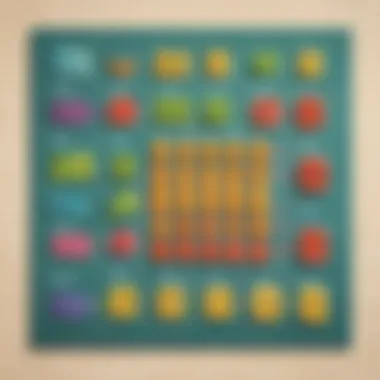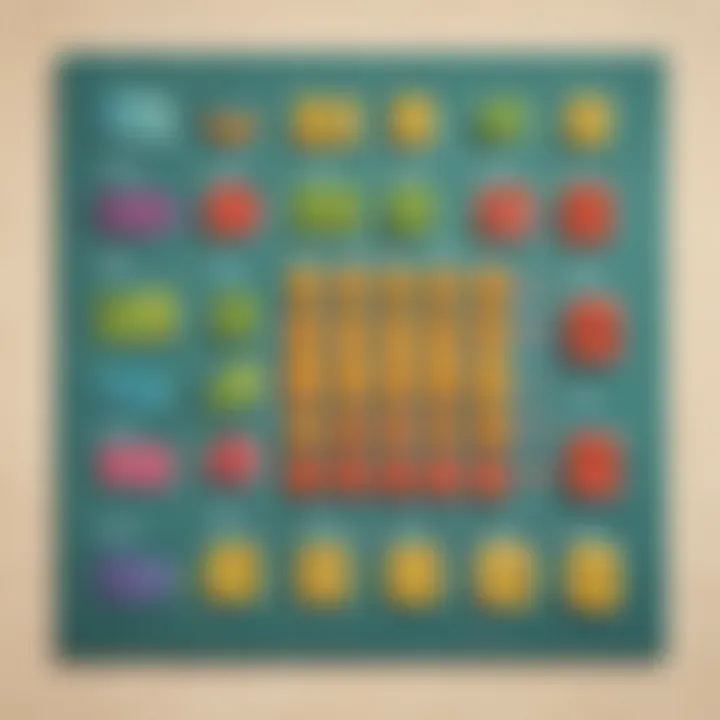In-Depth Guide to Key Mathematical Terms for Kids


Intro
Mathematics is like a vast ocean; it has many depths and shades. Each term or concept is a wave that could either lift a student up, or sometimes, drown them in confusion. For young learners, navigating this sea of numbers and symbols can be a daunting task. That's why we aim to simplify essential mathematical terminology to make learning a breeze for students aged five to twelve.
The glossary of math terms we'll explore isn’t just a list; it’s a toolkit for helping children understand the fundamentals. By breaking down complex ideas into pieces that are easy to digest, we can enhance their mathematical literacy and build confidence in their abilities.
Throughout this guide, we’ll touch on various branches of mathematics, each accompanied by engaging activities and insights. Let’s dive into the wonderful world of math and make it an exciting learning adventure!
Creative Activities
Craft Ideas
Engaging young minds in hands-on activities can be a game changer in their learning journey. Here are some creative craft ideas that can help illustrate basic mathematical concepts:
- Pattern Blocks: Use colored paper or foam pieces to create patterns, introducing children to geometric shapes and symmetry.
- Fraction Pizza: Cut a pizza shape from cardboard so kids can create their own fractions using removable toppings. It’s a tasty way to visualize parts of a whole.
- Number Line Art: Create a number line on a long strip of paper, and have kids color or draw pictures that correspond to each number.
Step-by-Step Guides
Each of these activities can easily be made at home. Here’s a step-by-step guide for the Fraction Pizza:
- Cut a large circle of cardboard to resemble a pizza.
- Prepare smaller circles of different colors to represent various toppings.
- Discuss what each topping represents in fractions (e.g., 1/8 for one slice of eight).
- Let kids place toppings on the pizza and explain their fractions.
- Once completed, encourage them to share their fraction pizzas with family or friends.
Educational Value
Involving children in these creative activities makes math tangible and fun. Through crafting, they absorb key concepts subliminally. For example, working with shapes helps improve spatial awareness, while fractions can enhance their understanding of division and parts of a whole. More than just play, these crafts can truly enrich their learning experience and keep them engaged.
Fun Quizzes
Quiz Topics
Quizzes can serve as a fantastic tool to gauge understanding and reinforce what kids have learned. Here are some topics we can cover:
- Basic Operations: Addition, subtraction, multiplication, and division.
- Geometry: Recognizing shapes, lines, angles, and symmetry.
- Measurements: Understanding units like inches, feet, and centimeters.
Question Types
These quizzes can include different kinds of questions to keep things interesting:
- Multiple choice questions where kids pick the right answer.
- Fill-in-the-blank questions that test their understanding of terms.
- True or false questions that prompt critical thinking about concepts.
Knowledge Reinforcement
Engaging with these quizzes allows children to test their knowledge in a laid-back, fun way. They can see how much they’ve learned and identify areas where they might need a bit more practice. Quizzes also encourage a sense of achievement and motivate them to keep learning.
Fact-Based Articles
Topics
There’s no shortage of fascinating topics to explore in math. Some can include:
- The history of mathematics and its evolution over time.
- Stories behind famous mathematicians and their contributions.
- Real-world applications of math in various careers.
Engaging Content
Fact-based articles should be written in a way that's both informative and easy to sift through. Using visuals and relatable examples can make complex ideas a bit more digestible for young readers. For instance, explaining how math is used in cooking by discussing measurements can help kids see the relevance of what they learn in real life.
Preface to Mathematics
Mathematics is often referred to as the universal language. It’s like a bridge that connects various fields, ranging from science to art, showing its significance across diverse domains. Without a solid grasp of mathematical principles, navigating through everyday tasks can feel like solving a jigsaw puzzle without having all the pieces. The concepts covered in this section aim to illuminate the foundational ideas of mathematics, making them more accessible and more engaging for young learners.
Understanding the Importance of Math
Mathematics is much more than just numbers and operations; it's a way to think critically and solve problems. Here are some reasons why understanding math is essential:
- Problem-Solving Skills: Engaging with math helps build the ability to analyze situations and come up with logical solutions. Whether it’s figuring out how much candy you can buy with your allowance or calculating how long it will take to travel to your grandma’s house, these skills matter.
- Foundation for Advanced Learning: Mastering basic math concepts lays the groundwork for more complex topics. Without a good understanding of addition and subtraction, learning multiplication would be akin to jumping into the deep end without knowing how to swim.
- Applicability to Daily Life: Math is everywhere, from cooking to budgeting. For instance, when cooking, knowing how to measure ingredients based on the number of servings needed can turn an ordinary meal into a culinary delight.
- Boosts Confidence: Successfully solving a math problem can provide a confidence boost. This feeling of accomplishment encourages students to tackle larger challenges, fostering a sense of resilience.
Furthermore, understanding math also helps in developing a systematic way of thinking. For young learners, these skills can empower them not only in their academic journey but in their everyday interactions too.
"Mathematics is the art ofgiving the same name to different things." - Henri Poincaré
Having a clear pathway to understand math boosts their literacy in mathematics, preparing them for future challenges. It's not just about memorizing facts; it’s about comprehending concepts that they will inevitably encounter in various aspects of life.
In this article, we will delve deeper into specific mathematical terms and their definitions. Each section is designed to foster a clearer understanding and to highlight the relevance of these terms within the broader context of learning.
Let’s embark on this exciting journey through mathematics, piecing together its many facets!
Basic Mathematical Operations
Understanding basic mathematical operations is crucial in building a stable foundation for all mathematical learning. These operations—addition, subtraction, multiplication, and division—are the building blocks that help young learners tackle more complex concepts as they progress in their education.
Mastering these basic operations equips children with the skills necessary for everyday tasks, whether it be budgeting their allowance, measuring ingredients for a recipe, or simply sharing candy with friends. Reinforcing these skills at an early age promotes confidence and competence in mathematics, making the school experience a lot smoother.
Addition: The Basics
Addition is the first mathematical operation that children typically learn. It is all about putting together groups of things to find a total. Imagine a group of apples. If you have three apples and then receive two more apples, the addition operation helps you determine how many apples you have altogether.
In mathematical terms, we can express this as follows:
3 + 2 = 5
This operation uses the plus sign (+), which signifies that we are combining quantities. Addition is not just about numbers; it's a process of gathering.
Benefits of Addition:
- It is intuitive and relates well to physical counting.
- It lays the groundwork for other operations such as subtraction and multiplication.
- It enables children to solve real-life problems.


Subtraction: Concept and Importance
Subtraction is often viewed as the opposite of addition. It involves taking away from a group. So, if we go back to our apples, if you start with five apples and give away two of them, a subtraction operation helps to determine how many you have left.
This can be written mathematically like so:
5 - 2 = 3
The minus sign (–) denotes the act of removing.
Importance of Subtraction:
- Subtraction encourages critical thinking as kids learn how to solve problems.
- It is essential for budgeting, telling time, and making sense of everyday situations.
- Understanding subtraction is necessary for mastering higher-level concepts, like algebra.
Multiplication Defined
Multiplication is simply repeated addition. Instead of saying,
- "I have four packs of stickers, and each pack has three stickers,"
we can say, - "I have 4 times 3 stickers."
In mathematical terms:
4 x 3 = 12
This operation allows for quick calculations and manages larger quantities efficiently.
Key Points on Multiplication:
- It’s essential in various fields such as science and finance.
- It helps in understanding patterns and relationships in numbers.
- Multiplication tables serve as a valuable tool in early education, assisting with memorization and quicker calculations.
Division Explained
Division breaks down a number into equal parts. For instance, if you have twelve cookies and want to share them among four friends equally, division helps you find out how many each friend gets.
The equation can be shown as:
12 ÷ 4 = 3
Here, the division sign (÷) shows that we’re dividing the total into smaller, equal groups.
Significance of Division:
- It instills fairness and sharing concepts, observable in daily interactions.
- Understanding division is pivotal in fractions and rational numbers.
- A solid grasp allows students to handle complex real-world problems involving rates and ratios.
Understanding these basic operations is like constructing a sturdy bridge that leads to higher mathematics. Each operation interlocks, providing support for learners to navigate the world of numbers with ease.
Understanding Numbers
Understanding numbers is like unlocking a whole new world of possibilities in math. Numbers are the building blocks, the unsung heroes, and they help us describe the world around us. In this section, we will dig into different types of numbers, how they fit together, and why they matter. Recognizing the diversity of numbers is essential for developing math literacy. It helps kids of all ages grasp concepts more easily and eventually apply them in real-life situations, like budgeting allowance or measuring ingredients for a recipe.
Types of Numbers: An Overview
Numbers are not just one-size-fits-all. They come in various forms, each with its unique characteristics. Here are the main types of numbers:
- Natural Numbers: These are the numbers we count with, like 1, 2, and 3. They are used in everyday counting.
- Whole Numbers: These are like natural numbers, but they also include 0, making them 0, 1, 2, 3, and so on.
- Integers: This set includes all whole numbers as well as their negative counterparts, like -1, -2, and -3.
- Rational Numbers: These can be expressed as a fraction of two integers, like 1/2 or 3/4.
- Irrational Numbers: These cannot be expressed as simple fractions. Examples include pi or the square root of 2.
- Prime Numbers: These are numbers greater than 1 that have no divisors other than 1 and themselves, like 2, 3, 5, and 7.
Understanding these categories of numbers allows students to recognize patterns, make calculations, and improve their problem-solving skills.
Whole Numbers and Integers
Whole numbers are the starting point for many math concepts. They be the simplest numbers to understand. They include all the natural numbers and, importantly, 0. So when we think about counting items, like apples in a basket, we use whole numbers.
Integers take the idea a step further. They include all positive whole numbers, zero, and negative numbers. For example, if you lose three dollars, you represent this with the integer -3. Realizing that integers encompass both gains and losses helps kids understand financial basics and even emotional contexts, like grades or sports scores.
Rational and Irrational Numbers
Now, let's jump into rational and irrational numbers. Rational numbers are a bit fancy but straightforward. If you can turn a number into a fraction where both the top and bottom are whole numbers, you've got a rational number.
An example? How about 1/2 or even -4? They have clear placements on a number line. In contrast, irrational numbers are trickier. They can’t be written as fractions. If you try to represent them with decimal points, they go on forever without repeating. Take pi, for instance. It starts as 3.14 but never ends! Grasping these concepts is key for future studies in algebra and geometry.
Prime Numbers and Their Significance
Prime numbers, often seen as the lone wolves of the number world, are fascinating. A prime number can only be divided by 1 and itself. So 5 is a prime number, but 6 is not because it can be divided by 1, 2, 3, and 6.
Recognizing prime numbers is vital for a variety of reasons. They are the building blocks for all numbers; every number can be broken down into prime factors. If kids learn about prime numbers, they will have a stronger foundation for working with fractions, understanding algorithms, and even getting into more complex topics like cryptography as they grow.
"Understanding different types of numbers is crucial for building a strong foundation in mathematics, and it prepares students for real-world applications and future learning opportunities."
Bringing it all together, numbers in their many forms help us to solve problems, comprehend situations, and navigate the world more effectively. Whether it’s counting your allowance or understanding complex equations later in life, the types of numbers we learn about now will serve as the groundwork for future mathematical exploration.
Mathematical Symbols and Their Meanings
Mathematical symbols are the backbone of mathematical expression. They serve as a universal language that helps communicate complex ideas in a succinct manner. Understanding these symbols isn't just for the sake of memorization; it’s about grasping the underlying concepts they represent. For young learners, this comprehension acts as a stepping stone into the more intricate world of mathematics. When children recognize what specific symbols signify, they can approach problems with more confidence and clarity, turning potential frustrations into moments of discovery.
Common Symbols in Arithmetic
In arithmetic, symbols are crucial. They enable individuals to perform calculations efficiently without needing to write out entire expressions. Here are some common arithmetic symbols:
- Addition (+): This symbol denotes bringing two or more quantities together. For example, in the expression 3 + 2, you are essentially combining three apples with two apples, resulting in five apples.
- Subtraction (−): This symbol indicates the removal of one quantity from another. The expression 5 − 2 represents having five candies and giving away two, leaving three candies.
- Multiplication (×): It signifies repeated addition. So, 4 × 3 can be viewed as adding four three times, which equals twelve.
- Division (÷): This symbol represents splitting a quantity into equal parts. In the expression 12 ÷ 4, you divide twelve into four equal groups, resulting in three.
These symbols form the core of basic arithmetic operations, and mastering them allows for smoother problem-solving.
Understanding Algebraic Symbols
As students progress from simple arithmetic to algebra, they encounter a new set of symbols. These are often introduced as abstract concepts which might initially seem intimidating. However, with a bit of exploration, their meanings become much clearer.
- Variables (e.g., x, y): These symbols represent unknown quantities. For example, in the equation x + 3 = 7, x represents the unknown number that, when added to three, yields seven. Solving for x would involve determining that x equals four.
- Equals (=): This symbol signifies equality between two expressions. It tells us that what is on the left side can be replaced by what is on the right side.
- Inequality Symbols (>, , >=, =): These symbols show the relationship between two values. For instance, if we say x > 5, it indicates that x is greater than five, suggesting all values that x can take must exceed five.
- Parentheses ( ): They tell us which operations to perform first in expressions. The expression (2 + 3) × 4 means that you first add two and three, and then multiply the result by four.
In algebra, recognizing and interpreting these symbols allows students to approach mathematical challenges in a structured manner. Grasping their meanings can transform a seemingly convoluted problem into a straightforward task.
Understanding mathematical symbols isn't simply about memorizing them. It’s about using them to think critically and solve problems with ease.
Geometry Basics


Geometry is not just a subject found in textbooks. It’s a true cornerstone of reality that helps us navigate the world around us. Understanding geometry is essential for young learners, as it not only enhances their spatial reasoning but also lays the groundwork for more advanced mathematical concepts. From measuring walls to designing objects, geometry teaches skills that have practical application.
Defining Shapes and Angles
Shapes are everywhere. When trying to sum up geometry, shapes often come to the fore. A shape can be anything from a simple circle to complex polygons. Each shape features unique properties that distinguish it from others. For instance, the difference between a triangle and a square isn’t just in the number of sides they have, but also in angles and how they can rotate.
Angles, meanwhile, refer to the space between two intersecting lines. There are different types of angles:
- Acute angles (less than 90 degrees): sharp and pointy.
- Right angles (exactly 90 degrees): they form the corners of squares.
- Obtuse angles (more than 90 degrees but less than 180 degrees): these are the "gotta-stretch-more" angles.
Recognizing these shapes and angles in real-life scenarios, like observing the triangular rooftops or rectangular windows, helps solidify their understanding.
Understanding Area and Perimeter
The area and perimeter are two key concepts in geometry, crucial for young minds to grasp.
- Area refers to the amount of space within a shape. For example, knowing how much space a lawn takes up or how much fabric is needed for a dress. The formula for calculating the area of a rectangle is length multiplied by width. This helps students visualize practical problems, such as measuring a classroom floor.
- Perimeter is the distance around a shape. Imagine wrapping a string right around a sandbox; that's finding the perimeter! For rectangles, the perimeter is calculated by adding all sides together. This reinforces the idea that geometry is utilized in everyday life, making it relatable to children.
Learning both area and perimeter not only builds foundational math skills, but also encourages problem-solving abilities and adaptability during various tasks.
"Geometry is not just about shapes and angles; it’s about seeing the world differently."
By delving into the basics of geometry, kids can appreciate the logic behind shapes and measurements. With practice, they will become adept at solving problems related to geometry, all while having fun discovering the beautiful patterns around them.
Foreword to Fractions
Fractions are more than just a numerical curiosity; they form a cornerstone in the world of mathematics. A fraction represents a part of a whole, which is quite essential for understanding numbers beyond just whole amounts. In this article targeted for young learners, parents, and caregivers, we break down the myths surrounding fractions, highlighting how they work and why they matter. Grasping the concept of fractions sets the stage for more advanced topics—like ratios, percentages, and even algebra.
When kids understand fractions, they begin to see the connections between different types of numbers. It allows them to enjoy cooking, baking, or even dividing a pizza among friends. This section will guide them through the journey of fractions, making it all less daunting and a lot more interesting.
Defining Fractions
At its simplest, a fraction consists of two parts: the numerator and the denominator. The numerator, sitting atop the fraction, tells us how many parts we have. Meanwhile, the denominator below indicates how many total parts the whole is divided into. For instance, in the fraction ¾, "3" is the numerator and "4" is the denominator. This fraction means you have 3 out of 4 equal parts of something.
It's crucial for learners to visualize fractions. Imagine a chocolate bar divided into four equal pieces. If you have three pieces, you can say you have ¾ of the chocolate bar. This not only helps in understanding but also in relating fractions to real-life scenarios.
Adding and Subtracting Fractions
Adding and subtracting fractions can be a breeze once you get the hang of it. The key lies in the denominators. When the denominators are the same, just add or subtract the numerators while keeping the denominator unchanged. For example, if you want to add ⅓ and ⅓, you simply add the numerators: 1 + 1 = 2, thus making it ⅔.
However, if the denominators differ, things can be a tad trickier. Take the fractions ½ and ⅓. Here, you need to find a common denominator—usually the least common multiple. In this case, it’s 6. You convert them: ½ becomes 3/6 and ⅓ becomes 2/6. Now, it's easy—3/6 + 2/6 = 5/6.
This method of finding common denominators is vital for successful calculations when dealing with fractions. It could seem confusing at first, but practice makes perfect!
Multiplying and Dividing Fractions
Multiplying fractions is simpler than many might assume. You just multiply the numerators together and the denominators together. For example, multiplying ⅔ by ¼ involves calculating (2 × 1) on top and (3 × 4) on the bottom, getting 2/12. Don’t forget to simplify your answer!
Dividing fractions requires a small twist to the process: instead of dividing by a fraction, you multiply by its reciprocal. For example, to divide ⅔ by ¼, flip the second fraction (make ¼ into 4/1) and multiply: (⅔) × (4/1) = 8/3. Understanding this can lighten the whole process and enhance calculation speed.
In summary, fractions are fundamental to a child's education in mathematics. By grasping how to define, add, subtract, multiply, and divide fractions, young learners gain confidence in their math skills. This lays the groundwork for more complex problems later on.
Exploring Time and Measurement
Exploring the domains of time and measurement is crucial for young learners as it lays down the groundwork for understanding how the world is structured around them. Mathematics is not only about numbers on a page; it's also about how those numbers connect to the world. By grappling with these concepts, students begin to grasp the significance of both measuring quantities and recognizing the flow of time in their daily lives.
Understanding time helps children plan their activities, understand schedules, and appreciate the rhythm of day-to-day life. Measurement units, meanwhile, are essential for assessing everything from the length of a pencil to the weight of a pet. These skills are not merely academic; they equip students with tools to navigate their environment adeptly.
Both time and measurement are intertwined with numerous daily activities, reinforcing how mathematics actually translates to real-life applications. To further solidify these principles, let's break it down into two pivotal subsections.
Understanding Units of Time
Units of time form the backbone of how we organize our lives. From the moment we wake up, time dictates the rhythm of our activities—school starts, lunch breaks, and bedtime all rely on an understanding of time.
The fundamental units of time include:
- Seconds: The smallest standard unit, a building block for larger units.
- Minutes: Comprises 60 seconds; often used in daily schedules.
- Hours: Made up of 60 minutes; crucial for understanding the broader scope of the day.
- Days, Weeks, and Months: Support a greater understanding of seasons and longer-term planning.
Knowing how to read a clock and understanding the concept of AM and PM can be significant. Not only does it enhance comprehension of time but also helps children appreciate punctuality and coordination with others.
"Time is what we want most, but what we use worst." – William Penn
As children grow, they can expand their grasp of time to more complex ideas, such as time zones, daylight saving, and even significant historical moments marked by time. These concepts further enrich their understanding and inspire curiosity about events in the past.
Measurement Units: Length, Weight, and Volume
Measurement is not just about sizes and weights; it's about making sense of the world. Whether you're baking, building a tower of blocks, or measuring a new desk for your room, knowing how to measure correctly is fundamental. The three primary types of measurement include length, weight, and volume.
- Length: Typically measured in centimeters, meters, inches, or feet. Understanding how long or short something is can help solve many practical problems, like fitting a new couch into a living room.
- Weight: Commonly measured in grams and kilograms, or pounds. Knowing how heavy something is can assist in cooking, shopping, and even sports activities where one needs to manage weight for various reasons.
- Volume: Usually expressed in liters or gallons. This measurement is pertinent when pouring drinks or determining how much water a container can hold.
By introducing these units, children learn not only how to quantify different entities but also how to convert between them. For instance, converting centimeters to meters could seem complex, but with some practice, kids can get the hang of it.
The learning process becomes engaging when students are encouraged to use these measurements in real-life scenarios. Practical applications such as cooking recipes involve measuring volumes, carpentry deals with lengths, and sports can relate to weight.
In sum, understanding time and measurement employs mathematics in a relatable context, fostering significant skills that extend far beyond the classroom. The impact of these concepts can be profound, setting the stage for a lifetime of aware and informed decision-making.
Basic Statistics
Statistics is like a window into the world of numbers. It helps us understand what data can tell us, allowing us to make sense out of everyday information. In this section, we delve into the fundamental concepts of statistics, focusing on elements such as mean, median, and mode, and how they contribute to our understanding of data.
Whether we're looking at a sports team's scores or the number of books read in a month, basic statistics helps us summarize and analyze data accurately. This is especially important for young learners as they start to encounter data in various subjects, making the learning process both engaging and intuitive.
Understanding Mean, Median, and Mode
When it comes to summarizing data, three terms often pop up: mean, median, and mode. Each of these concepts helps us understand data in a different way.


- Mean is the average of a set of numbers. For example, if a student scores 80, 85, and 90 on three tests, the mean would be calculated as follows:(80 + 85 + 90) / 3 = 85
This number gives an overall idea of the student's performance.
- Median is the middle number when all the values are arranged in order. Using the same group of test scores, we find that if scores were 80, 85, and 90, the median is also 85, since it's the middle value. This can be very useful when there are extreme values affecting the average, as it gives a better picture of the set.
- Mode is the number that appears most frequently in a data set. If a student has the following scores: 85, 90, 85, and 80, the mode would be 85 since it occurs twice.
Combining these statistics can help paint a fuller picture of the data being analyzed, guiding students to draw better conclusions.
Foreword to Graphs and Charts
Graphs and charts are essential tools in statistics. They allow us to visualize numbers in a way that is easy to understand.
- Bar graphs help represent data with rectangular bars, where the length of each bar corresponds to the value it represents. For instance, if you wanted to show the number of pets owned by your friends, you could use a bar graph where each bar represents a different type of pet.
- Pie charts are circular graphs divided into slices. Each slice illustrates the proportion of each category in relation to the whole. If you want to depict how much time you spend on various activities during the day, a pie chart would quickly show which activities take up the most time.
- Line graphs track changes over time. For example, you can show how your reading skills have improved over school months by plotting scores on a line graph.
Using these graphics not only makes data easier to digest but also brings clarity to the information. They can often reveal trends and patterns that numbers alone might hide, making learning more interesting and interactive.
Basic statistics serves as a foundation for critical thinking about data. It encourages curiosity and promotes informed decision-making, which is essential for young learners.
As students grasp these concepts, they build a sturdy base for more complex statistical topics later in their education journey.
Preface to Probability
Probability is a topic that people often overlook in math conversations, but it plays an essential role in helping us understand the world around us. Think about it: every time you step outside, there’s a chance of rain or of it being sunny. That’s probability in action! In this section, we’ll explore the basics of probability, its significance in our daily lives, and why knowing a bit about it can be quite helpful, especially for young learners.
Understanding probability gives children a foundation on which they can build decision-making skills and critical thinking. When kids grasp the concept of chance, they start to see how it applies not just in math class, but in games they play, in sports they enjoy, and in real-world situations, too. That being said, let's dive deeper into the basic concepts.
Basic Concepts of Probability
So, what exactly is probability? Simply put, it is a measure of how likely something is to occur. The idea of chance can sometimes feel like magic, but, actually, it follows rules and patterns. Let’s break down some of the core concepts in probability to create a clearer picture:
- Experiment: This is a process that leads to one or more outcomes. For example, tossing a coin is an experiment. The outcome can either be heads or tails.
- Outcome: This is the result of an experiment. In our coin toss, heads and tails are outcomes.
- Event: This term refers to a specific set of outcomes. For instance, getting heads in the coin toss is one event.
- Sample Space: This is a fancy term for all possible outcomes of an experiment. In our coin example, the sample space would be Heads, Tails.
Now, let’s consider the way we express probability using a simple formula:
Probability of an event = (Number of favorable outcomes) / (Total number of possible outcomes)
For example, if we toss a fair coin, the probability of landing on heads would be:
- Number of favorable outcomes (getting heads) = 1
- Total possible outcomes = 2 (heads or tails)
So, the probability is 1/2 or 50%.
Why is Probability Important?
Understanding these fundamental ideas opens the door to numerous benefits:
- Decision Making: Kids learn to make informed choices based on potential outcomes, which is a life skill that serves them in school and beyond.
- Critical Thinking: Analyzing situations based on chance helps develop logical reasoning.
- Fun with Games: Many games rely on probability. Knowing how it works can enhance their game-playing strategy.
- Real-Life Applications: From sports, weather forecasts, to various scientific studies, probability is everywhere. Awareness of this can nurture curiosity.
Now that we've laid that groundwork, let's explore more as we continue our mathematical journey!
The Role of Math in Daily Life
Math is more than just numbers and equations; it weaves itself into the very fabric of our day-to-day lives. From the moment you wake up and check the time to your school lessons, mathematics is silently at play, shaping a world of possibilities and critical thinking. Understanding math’s role is not only essential for grasping fundamental theories but also crucial for navigating daily tasks.
When kids grasp how math connects to real-world situations, it can light a spark of interest and enthusiasm. Math provides tools for problem-solving and fosters logical reasoning, which are valuable across all areas of life. Here are a few reasons why math matters:
- Everyday Decisions: Whether budgeting pocket money or calculating snack portions, math helps young learners develop decision-making skills that will carry into adulthood.
- Time Management: Telling time is a fundamental skill. Knowing how to read both digital and analog clocks allows children to manage their daily schedules effectively.
- Shopping Skills: When kids join parents in grocery stores, understanding prices, discounts, and calculations on sale items teaches them important lessons about values and money.
- Cooking and Baking: Recipes often require measuring ingredients, adjusting portions, and timing cooking steps, making math both practical and fun in the kitchen.
"Mathematics is the language in which God has written the universe." - Galileo Galilei
By linking mathematical concepts to real life, educators can transform abstract theories into tangible knowledge, enriching the educational experience for children.
Practical Applications of Mathematics
The real beauty of mathematics lies in its practicality. When young students see the relevance of their lessons, it can inspire them to dive deeper into the subject. Here’s how math is commonly applied in real life:
- Financial Literacy: Understanding basic financial concepts such as saving, spending, and interest rates prepares kids for later responsibilities. Learning how to manage money can help prevent future financial pitfalls.
- Sports Strategy: Math enhances sports appreciation. Statistics about scores, averages, and player performances provide insights into game strategies, teaching students analytical thinking.
- Environmental Awareness: Analyzing data related to recycling and resource usage allows students to understand the impact of their choices on the environment.
- Art and Design: Geometry plays a critical role in art. Exploring patterns, symmetry, and spatial relationships can help kids appreciate both math and creative skills.
- Navigational Skills: Understanding coordinates and maps can enhance children’s abilities to navigate in their communities or while traveling.
By integrating these practical applications into classrooms, teachers can create a learning environment linking math to everyday experiences, making it much more relevant.
Strategies for Learning Math Terms
Learning math can sometimes feel like climbing a mountain, especially when faced with a ton of unfamiliar terms. Getting a grip on mathematical terminology is crucial, not just for understanding the content but also for effectively applying it in various situations. This section will unravel several strategies that can turn what seems like a tough climb into a smooth stroll down a sunny path.
Tips and Techniques for Memorization
Memorization can be tricky, but employing the right techniques can make it a walk in the park. Here are some tips to help young learners remember math terms more easily:
- Use Flashcards: Create flashcards for each term. On one side, write the term, and on the other, jot down its definition. This interactive method is especially effective, as it engages multiple senses and reinforces memory through repetition.
- Group by Themes: Group related terms together. For example, terms related to geometry, like ‘angle’, ‘vertex’, or ‘polygon’, can be learned as a set. This not only aids recall but also helps kids see connections between concepts.
- Create Mnemonics: Developing silly phrases or acronyms can help cement terms in memory. For instance, to remember the order of operations (Parentheses, Exponents, Multiplication and Division, Addition and Subtraction), one might use: "Please Excuse My Dear Aunt Sally."
- Engage with the Content: Find ways to integrate math language into daily life. Talk about shapes you see around, or use cooking to explain fractions. Real-world applications might help terms stick deeper in the mind.
"Understanding math terms is like having a toolbox. The more tools you have, the easier it is to solve any problem!"
Interactive Learning Tools
Interactive learning tools are vital in making the process of grasping math terms enjoyable and effective. Here's how these tools can make a difference:
- Educational Apps: Platforms like Khan Academy or Prodigy provide engaging math games that introduce terms in a fun environment. They help reinforce learning while also making it less daunting for students.
- Math Games: Playing board games or video games that involve math can create interest in the vocabulary. Games like Monopoly can introduce concepts like money management and basic arithmetic in a spirited, enjoyable manner.
- Online Platforms: Websites such as Mathletics and IXL offer numerous exercises targeting specific terminology. They allow learners to practice at their own pace and revisit challenging terms.
- Group Learning Activities: Interactive group activities, where students quiz each other with prepared questions or play math-based games, can significantly improve understanding while also promoting camaraderie.
End
The conclusion serves as a pivotal part of our exploration into mathematical terms. It acts like the exclamation point at the end of a complete thought, reinforcing the ideas discussed throughout the article. In the broader scheme of learning, it helps summarise the journey taken through the maze of math terminology. With each concept and term learned, students build more than just knowledge; they cultivate a sense of confidence and familiarity with the subject.
Recap of Key Terms and Expressions
In wrapping up this comprehensive guide, it’s essential to revisit the key terms that have been highlighted. These terms are the building blocks of mathematical understanding:
- Addition: The process of combining two or more numbers to get a total.
- Subtraction: Detracting one number from another, revealing how much remains.
- Fractions: A way to represent part of a whole, expressing division between numbers.
- Prime Numbers: An intriguing set of numbers greater than one that have only two factors: one and themselves.
- Probability: The likelihood of an event occurring, a concept that's invaluable in decision-making.
These are not just terms; they are tools that children can wield in various scenarios, whether calculating their change after shopping or figuring out how many friends can share a pizza. By grasping these definitions, young learners strengthen their mathematical literacy and set the stage for future academic success.
Remember: Mastering math terms is a stepping stone towards becoming proficient in broader mathematical concepts.
With these insights, caregivers and educators play a crucial role. They can encourage practice, discussions, and exploration around these terms. The engagement nurtures not only understanding but also a love for mathematics, making it an enriching experience for everyone involved. As we conclude, let’s ensure that these building blocks facilitate a smoother path through the intricate world of mathematics in the future.







